Mealtime Partners, Inc.
Specializing in Assistive Dining and Drinking Equipment
February 2021 Independent Eating and Drinking Newsletter

|
February Topics:
|
||
|
Mealtime Partners Home Page Send a Comment or Suggestion |
|||
| Subscribe to Newsletters, or Unsubscribe from Newsletters |
Why Do We Think Something is Cute?
Have you ever wondered why, when you see certain things like babies, puppies and kittens that you respond to them with a warm feeling that makes you think that it is cute?
Ethology is the scientific study of animal behavior, especially as it occurs in a natural Environment. Konrad Lorenz, an Austrian ethologist developed a concept known as Kinderchenschema, or "baby schema" in English. Baby schema refers to physical features of the head and body of infants in both humans and other mammals that are perceived of as being cute and elicit a caretaking response. Baby schema features in humans include a large head (relative to their body) with a high forehead and chubby cheeks, large eyes, and a small nose and ears. Of course, these features will disappear as the baby ages.
(To test this reaction for yourself, watch a little bit of the YouTube video at This LINK and see what your own responses are.)
As mammals evolved their brains became bigger and there came a point at which the infants head would be unable to pass through the birth canal if their brain got any bigger. At this point in evolution, babies were born while the brain still needed to grow to be fully developed. The infant at birth is helpless and must rely on its mother or both mother and father to care for it or it will not survive. Lorenz hypothesized that the baby schema response was a built-in behavior developed to elicit caregiving. However, it was unproven for decades due to the limited tools available to measure brain activity. Now that functional magnetic resonance imaging (fMRI), magnetoencephalography (MEG), and other types of brain scans are available, researchers have been able to test Lorenzo’s hypothesis.
A wide range of studies have been conducted to evaluate the brain response to pictures of babies with more or less baby schema from both men and women. Results showed that not only was there a response to the images in the visual cortex (which was expected as it is a response to recognition) but also there was very rapid activity in the emotional part of the brain which is linked to reward motivated behavior.
The concept that baby schema responses might not be limited only to visual cues but might extend to other prompts was tested and the findings showed that people also responded to baby sounds, both positive and negative. Recordings of babies giggle, babbling, or crying as well as sounds of adults, and animals making similar types of sounds were played for study participants. It was found that brain activity responded to a baby crying faster than to any other sounds. However, the brain responses did not come from the reward portion of the brain (discussed in the previous paragraph) but came from an area of the brain associated with survival responses. It seems our brains respond to babies regardless of which way we become aware of them. Finally, it has been shown that once their brain has been “woken up to a baby”, they stay on high alert. After hearing a baby crying, volunteers who were tested for dexterity, responded more quickly and accurately than volunteers who listened to other sounds prior to being tested.
Even though the information in this article is brief, it provides insight into how we respond to infants and what triggers us to react in this way.
References:
M. L. Glocker, D.D. Langleben, K.Ruparel, J.W. Loughead, R.C. Gur, and N.Sachser. Baby Schema in Infant Faces Induces Cuteness Perception and Motivation for Caretaking in Adults. Ethology. 2009 Mar; 115(3):257-263.
G.Tarlach. Getting Cute, New Science Reveals its Power Goes Way Beyond Babies. Discover Magazine December 2009.
| Independent Drinking |
|
For most individuals, dehydration is 100% preventable. However,
many people with disabilities suffer from some level of dehydration almost
constantly. Mealtime Partners various drinking systems allow many individuals
who are unable to use their hands to take a drink, to drink independently. For
example, the Hydration Backpack with Drinking Tube Positioning (pictured below)
provides hands free drinking throughout the day for those who
sit in a wheelchair and are unable to lift or hold a cup or glass. The drinking
system is quick and easy to set up, the liquid container fits on the back of a
wheelchair and the drinking tube can be positioned to meet the unique
positioning needs of each individual. |
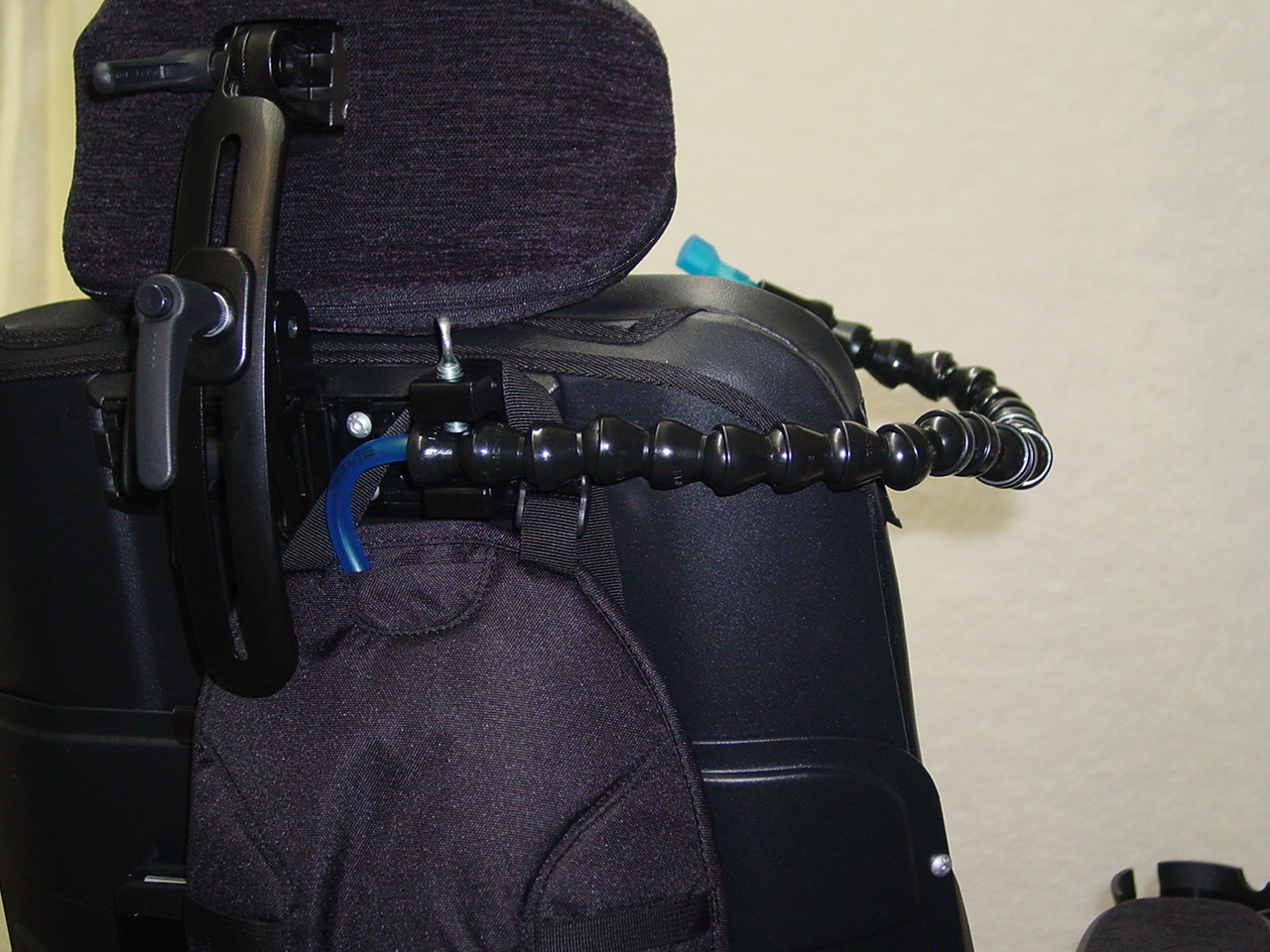
|
| Easy to install and remove from the wheelchair to fill or clean. |
|
|
| Hands-free drinking, 70 fluid ounces of water available for people on the go! |
| The Front Mounted Drinking Systems pictured below, can position a variety of cups and drink containers very close to the users mouth for hands free drinking and allows a variety of other drinks to be made available throughout the day. For example, coffee in the morning, ice tea with lunch, a can of soda in the afternoon and a glass of milk before bed. The user drinks from their own container using a disposable straw. Because the straws and most of the containers can be disposed of, or washed in a dishwasher, it is the easiest drinking system to clean. It is available in several lengths of flex-arms and can be mounted on a variety of wheelchairs. |
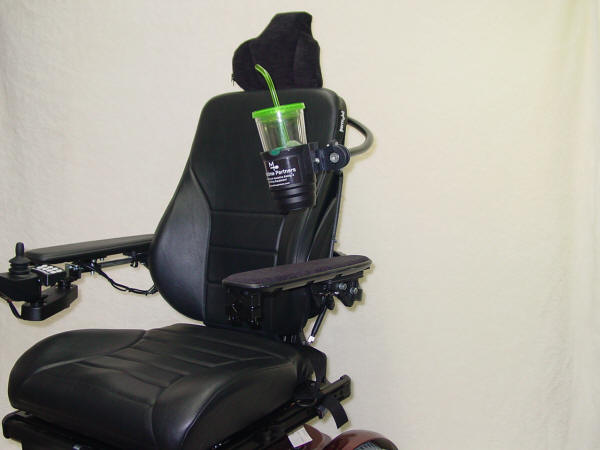 |
Front Mounted Drinking System with
UniTrack Mounting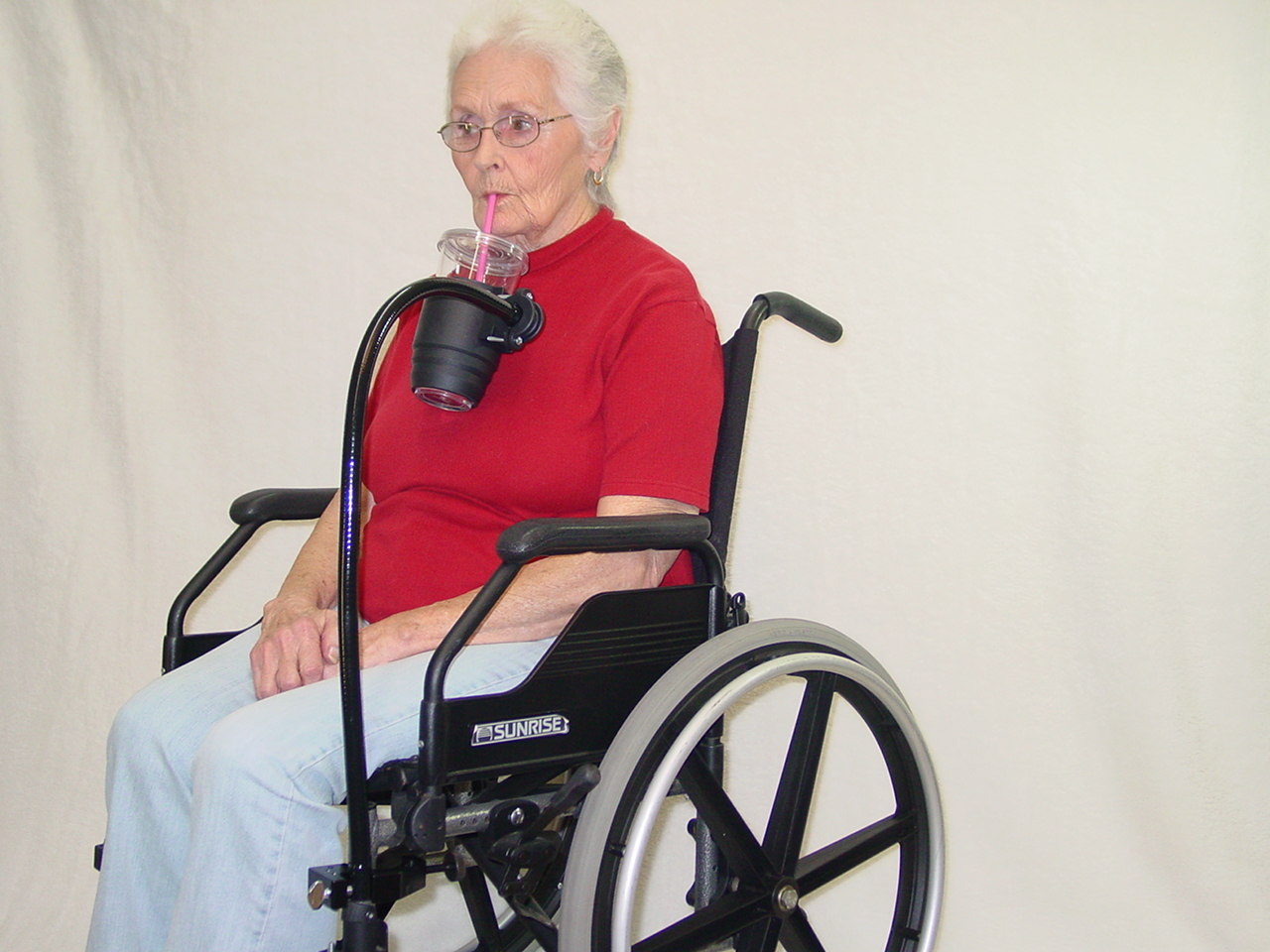 Front Mounted Drinking System on Manual Wheelchair |
| All of the Mealtime Partners drinking systems are available for attaching to manual wheelchairs (i.e., wheelchairs with a tubular handle or other tubular structural components) and for wheelchairs with the Slide-Track mounting rails. For more information about all of our drinking products, click here, or call us at 800-996-8607. |
How to Attach Accessories to Wheelchairs and Beds
At the time Mealtime Partners started developing drinking systems, all wheelchairs, whether they were powered or manual, had tubular or square metal frames, and handles. This made clamping to wheelchairs quite straight forward. We used our Wheelchair Clamp (Figure 1) for attaching all of our drinking systems and mounting systems to any brand of wheelchair. Similarly, hospital bed rails were tubular metal and the same clamp could be used to attach drinking systems to a hospital bed.
|
|
| Figure 1: The Wheelchair Clamp (Part No. 4960) |
| The opening on the right attaches to a wheelchair or bed, and the opening on the left holds the drinking system or mounting system. |
Over time, wheelchair and hospital bed designs have evolved. Many hospital beds now have plastic bed rails that have electronic controls integrated into them (as shown in Figure 2, below). The patient or hospital staff can raise and lower the bed head or foot using buttons that are part of the bed rail, as well as perform other functions (depending upon the make and model of the bed). This new bed rail design prohibited our original wheelchair clamp from firmly attaching to the rail as the plastic gives under the pressure of the clamp, allowing the clamp to loosen and alter its position over time. To address the problem created by the new bed rail design and to continue satisfying the need to provide hands-free hydration to people who are in hospital beds, Mealtime Partners developed the Hospital Bed Clamp (also shown in Figure 2). This clamp holds firmly on plastic bed rails because it distributes the required holding pressure over a large area of the plastic rails. The top and bottom portions of the clamp fit between the openings in the bed rail. Once it is installed, the Hospital Bed Clamp maintains its position, indefinitely.
|
|
| Figure 2: The Hospital Bed Clamp (Part No. 4980) |
Drinking systems can be mounted on the hospital bed clamp using the attachment holder on the exterior of the clamp. Either flex tubing, or flex arms, can be installed in the attachment holder, therefore, a variety of drinking systems can be made available to a person who is in bed.
Many of the more recently manufactured wheelchairs do not have tubular frames as part of their structure. They are made up of a base unit that holds the wheels, motors, batteries and electronics, and a seating system that is added to the base. The seating systems are customized to meet the needs of each individual even though they are made up of standard components. To efficiently integrate all of the components needed by each individual, many wheelchair manufacturers designed rails that have tracks (i.e., slots) in them where accessories can be attached. (A T-shaped nut is inserted into the slot and components can be screwed into the threaded hole in the nut.)
These rails are installed at various locations on a wheelchair seating system. Common locations are along the edges of the seat base, on the seat back, on the sides of the seat back, and under the armrests. Seating components that are mounted on the tracks include armrests, head rests, lateral supports, and joysticks and their associated drive controls. The great value of this method of developing a seating system is that all of the components that make up the seating system can be positioned exactly where they are needed for each individual. For example, the arm rests do not necessarily need to be positioned parallel to each other. For someone who has skeletal anomalies it might be more appropriate for the armrests to be slightly staggered. Thus a wheelchair can now be unique to its user and yet be made up of an assortment of standard parts.
Permobil chose to use a rail that has two tracks. All other wheelchair manufactures use rails with a single track. There are several terms used to describe these rails but there is no one single descriptor that is used throughout the industry. Mealtime Partners has chosen to use the term slide-tracks to describe all of the mounting rails variations that are used on wheelchairs Also, it should be noted that the two slots in Permobil wheelchair slide-tracks are smaller than those in all other slide-tracks and, therefore, require a slightly smaller T-Nut.
To address mounting drinking systems to these wheelchairs, Mealtime Partners developed a method of attaching the hands-free drinking systems to wheelchairs with slide-tracks. Three different clamping systems have been developed, as shown in Figure 3, below. Two are quite similar; they allow the Flex Arms that are used in all of the Mealtime Partners Front Mounted Drinking Systems and Adaptive Switch Mounting Systems to be attached to slide-tracks. The only difference is that the Flex Arm Holder used for drinking systems is tightened using knobs that can be tightened and loosened by hand, while the Flex Arm Holder used for Adaptive Switch Mounting is tightened and loosened using a hex key. Use the Flex Arm Holder with Knobs (Part No. 7971) if the Flex Arm will be removed or adjusted frequently and use the Holder without Knobs (Part No. 7970) for a more permanent installation and using a hex wrench (that comes with the Holder) will not present a problem. The third slide-track mount is the Attachment Holder for slide-track that is used to fasten the flex tubing that is used in Hydration Backpacks with Drinking Tube Positioning to the wheelchair.
_assembly.jpg)
|
_assembly.jpg)
|
%20Rendering-%20Vertical.jpg)
|
| Flex Arm Holder for Slide-Track (4970) | Flex Arm Holder with Knobs for Slide-Track (4971) | Attachment Holder for Slide-Track (4973) |
| Figure 3 - Three methods for attaching accessories to Slide-Track | ||
The method used to attach these systems to slide-tracks uses a special T-nut (as illustrated in the three parts shown above). The T-nut is inserted into the slot (or track) in the slide-track. Figure 4, below, shows a T-Nut being inserted into the standard slide-track slot (left) and the top slot of a UniTrack slide-track (right).
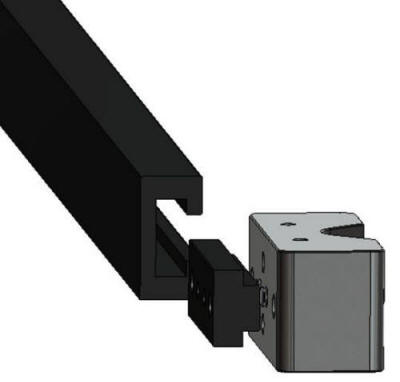
|
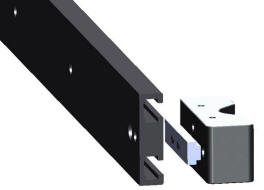
|
| Standard Slide-Track End Section | UniTrack Slide-Track End Section |
| Figure 4 - Slide-Track End Sections | |
The one remaining problem that Mealtime Partners had to solve was how to accommodate both sizes of slide-tracks. To address this need, two different sized T-nuts are available. The smaller T-nut is called the UniTrack T-nut and is to be used on Permobil wheelchair slide-tracks. The larger T-nut is called the Standard T-nut and is designed to accommodate all other types of wheelchair slide-tracks. When ordering drinking or mounting systems for wheelchairs with slide-tracks you will need to specify the type of wheelchair on which it is going to be mounted.
Mealtime Partners has now made all of its drinking and mounting products available for mounting on any wheelchair. For manual wheelchairs, older powered wheelchairs, or metal railed hospital beds, the original wheelchair clamp can be used. The slide-track mounting systems can accommodate all of the newer powered wheelchairs and the hospital bed clamp can mount on several different plastic railed hospital beds. Photographs of our various drinking systems are shown in the advertisement just above this article.
If you have questions about mounting on a specific wheelchair or bed, please contact us at info@mealtimepartners.com, or call us at 800-996-8607. We are always happy to help!
|
Did You Know?
Did you know that Ross King,
a scientist at Chalmers University of Technology in Sweden,
has built the first machine that is capable of conducting,
fully automatically, the scientific process and making
discoveries on its own? King calls the machine Adam as it
was the beginning of this research which he started in 2004
to study enzymes in yeast. He next developed a second robot
to search for malaria drugs and he called the second robot
Eve! King describes Adam and Eve as robot scientists. They
are a combination of robotic laboratory equipment and
artificial intelligence and they get smarter with each
iteration of their development. Adam and Eve have no
resemblance to humanoid robots. They are about the side of
an office cubicle and are made up of robot arms, incubators,
a freezer, cameras, etc. Basically everything that a human
would have in a laboratory. Machines like Adam and Eve can make a researcher far more productive and are becoming more and more common. You can learn more about this at: https://www.discovermagazine.com/technology/the-robot-scientists-are-coming-but-thats-not-a-bad-thing. |
Mealtime Partners Website Navigation:
Home | Dining | Drinking | Videos | All Products | Warranty | Ordering | Calendar | FAQ | Newsletters | Contact
Please send comments and suggestions to newsletters@mealtimepartners.com
Copyright © Mealtime Partners, Inc. 2021
All rights reserved.